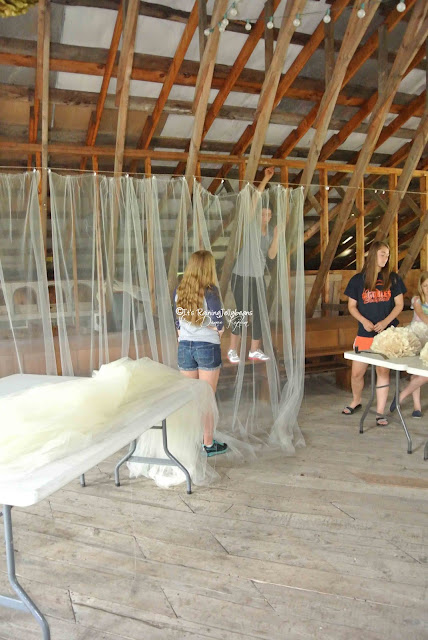Today I wanted to talk about the beautiful Tulle Walls that ran the length of the right side of the barn. This was a project that became so much more than I expected.
Originally Brandin showed me this photo. She really loved the look. The problem(s)? One issue was where to use it? She didn't want a traditional "head table" so we couldn't run it behind the wedding party which seemed the most obvious place to me. The inspiration photo showed it behind the dessert buffet which is an option. Unfortunately (or not) the area that we used for the pies and desserts didn't need this type of backdrop and would have in fact detracted from the finished look. In fact the walls weren't tall enough to NEED this type of treatment. The other big problem that I saw with replicating this exact look is the huge amount of tulle it would take in our big barn. Knotting the tulle like this is the easiest way to use it no doubt. This is the same technique used to make the no-saw tutus that mothers of girls under the age of 4 have been blowing up over on Pinterest for the last few years. While it is easy, it uses a lot of tulle. If you are making a tutu you want the poof that comes from knotting the tulle this way but if you are making a wall of tulle that runs the length of a big barn...ya might want to consider other options. By making the tulle into more of a curtain-by NOT doubling it on itself- we would save money. Maybe it was simply a (bad) timing issue, but when we were talking about making something similar and calculating how much tulle to purchase, it was at a time that Brandin was getting very stressed about how much she was already going over budget. Because we had limited local sources for tulle, we decided to go with a web-based company. That meant I had to get the order correct the first time. We wouldn't have time to order more later and returning something like that is difficult at best and a big waste of money for shipping at worst. So get it right the first time Danee! I asked my husband- the pilot/engineer/math lover- to help calculate what we needed. We ended up using Koyale Wholesale and ordered white tulle -a bolt that was 108"x50 yards ($79.99) and one that was 54"x40 yards ($19.99). This gave us enough to do what I originally planned which was several small "walls" of tulle scattered throughout the barn as well as a big buffer to play with.
Before we ordered the tulle, I planned to make a pocket across the top of the tulle to run twine though, tie the twine to the open barn studs and maybe use washers as weights to hold the tulle down. Several weeks before the wedding my husband was in Portland, OR and wandered into a store where he found some cheap clips he thought would be perfect for the tulle walls.
They were shiny silver-colored alligator clips with a loop at the top that could be threaded onto the twine. Even if I didn't run the twine through loop before tying it off, I could easily added it later simply by opening the loop like a jump ring. For only $1.99/pkg of 20 clips I was thrilled.
A little of Tim Holtz's Distress Paint in Picket Fence was all it took to knock down the shine and gave them a vintage look that fit better with the vintage wedding vibe. IT IS ALL ABOUT THE DETAILS PEOPLE. Don't forget that because it is always true when it comes to decor and art.
I used the dabber on the Distress Paint to simply dab the paint on the clips while they were still on the cardboard straight out of the package. The paint dries pretty quickly-maybe 15 minutes tops. 

Let's start with a photo of what the wall looked like early on the day of the wedding then I will show how it all went up. At home, I had cut a length of tulle and clipped it up on twine in front of my sliding-glass door to show Brandin. She wasn't thrilled and I didn't like the way it looked either. I hadn't gathered it, instead using the clip placement to give it some loose gathers.... and it looked bad. I left it in place for several days as I mulled over whether I wanted to deal with actually running a gathering stitch on ALL of the panels....the many many panels....on yards and yards of tulle. UGH!
When working with tulle, one of the biggest issue is that it wrinkles easily and it is HARD to get those wrinkles out once they are in. So I decided to hold off cutting the panels until I was at the barn ready to hang them. I left the tulle on the bolts until I was ready to use them; this is the best way to ensure a great looking (wrinkle-free) end result. But that meant taking my sewing machine to the barn...the barn WITHOUT electricity. Ok, so there was a little electricity. First, I had to make sure we would have power. The farmer let us use his battery (he keeps it charged using a generator). All I know is that there was a plug I attached a really long extension cord to, ran that up a flight of stairs and across to the sewing machine. As long as no one else needed power I was good. You weren't really shocked that I decided there was no option other than running a gathering stitch through all those yards and yards of tulle were you?
 |
| Me....I'm not really a Seamstress, but I did sleep at a Holiday Inn Express last night. |
I cut all the tulle into 8' lengths using a rotary cutter, self-healing mat and large clear acrylic ruler. I left the width folded the way it came on the bolt and simply unrolled it and cut it to length. Only then did I open it up to its full width. I ran a gathering stitch across the top of each panel of tulle about 2 inches down from the top edge using my sewing machine. A gathering stitch this is made by running two rows of stitching, about 1/4" apart with the stitch length lengthened to about 6 or 8 (depending on your machine). The goal is to have a stitch that is loose enough to allow the fabric to gather when one thread is pulled. Although you can do it with one row of stitching, it is best to run two rows; the second row is insurance in case the thread from the first row is accidentally pulled out or breaks. The gather is achieved by pulling one of the threads on the bottom row- this will cause the fabric to gather onto the other thread on the bottom row. Although it would be even more labor intensive, you could sew this by hand using a needle and thread and a lot of patience. How tight or loose the gather is isn't important at this point- that is something that will be determined when all the panels are hanging.
After I ran the stitch, Brandin's mom and niece actually pulled the strings to make the gather. Again it isn't important how tight you pull the gather at this point; just use a very rough estimate to just get the gathering started.
Brandin and her other niece hung the panels using the painted clips and rustic twine that was wrapped around nails in the beams. We used a level to ensure the twine was straight.
 |
| I made a few sweat shop jokes as I was still sitting and sewing hours later. |
This went on all day....and night..and the next day....and the night...and the next day...No it didn't. I lied...it was really only probably 4 or 5 hours.
 |
| The two fabrics that were intended for the bridesmaid's skirts. |
Begin with a piece of ribbon (or fabric) and make two loops with several inches between them.
Cross the loops and run loop 2 through the loop created by crossing loops 1 and 2.
Pull tight. You will have to adjust the bow but you will always get a great bow with loops hanging down.
The draping tulle and bows were held in place with clear tacks and tulle in place. Again, we used a level to ensure the drape and bows were even. The tulle was secured back to very other board. I love the way this gave us some drape but kept it from looking like it was a pregnant-tulle wall.
After the entire wall was in place we still had a few panels left. I used 2 of the wider (108") panels for the altar. The rest we used to help frame the doorways into the side "room" on the left side of the barn that housed the drink and dessert tables as well as the gift table. These were the smaller panels of 54" wide tulle.
We also used them to help hide the "kitchen area" from the main area.
Here I added seam binding bows.
Hope your day is filled with Sunshine and Glitter.
This post was linked to the following Linky Parties:














































This is awesome! I have been wracking my brain and Pinterest trying to figure out a solution to pretty up our detached and unfinished garage for our backyard reception. I also found the dessert table photo you have above and that was my original inspiration. This is a huge help! thanks for posting, it looks great!
ReplyDeleteWhen it said “so get it right the first time Danee!” I was impressed that the site could put my first name into the text. Then I realized the authors name really is Danee!! Even spelled like mine.
ReplyDelete